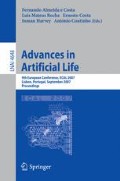Abstract
In the multi-foraging task studied in this paper, a group of robots has to efficiently retrieve two different types of prey to a nest. Robots have to decide when they leave the nest to forage and which prey to retrieve.
The goal of this study is to identify an efficient multi-foraging behaviour, where efficiency is defined as a function of the energy that is spent by the robots during exploration and gained when a prey is retrieved to the nest. We design and validate a mathematical model that is used to predict the optimal behaviour. We introduce a decision algorithm and use simulations to study its performance in a wide range of experimental situations with respect to the predictions of the mathematical model.
Access this chapter
Tax calculation will be finalised at checkout
Purchases are for personal use only
Preview
Unable to display preview. Download preview PDF.
References
Dorigo, M., Şahin, E.: Guest editorial. Special issue: Swarm robotics. Autonomous Robots 17(2–3), 111–113 (2004)
Balch, T.: Reward and diversity in multirobot foraging. In: Workshop on Agents Learning About and with Other Agents (IJCAI-99), Stockholm, Sweden (1999)
Charnov, E.L.: Optimal foraging, the marginal value theorem. Theoretical Population Biology 9(2), 129–136 (1976)
Ulam, P., Balch, T.: Using optimal foraging models to evaluate learned robotic foraging behavior. Adaptive Behavior - Animals, Animats, Software Agents, Robots, Adaptive Systems 12(3-4), 213–222 (2004)
Labella, T.H., Dorigo, M., Deneubourg, J.-L.: Efficiency and task allocation in prey retrieval. In: Ijspeert, A.J., Murata, M., Wakamiya, N. (eds.) BioADIT 2004. LNCS, vol. 3141, pp. 274–289. Springer, Heidelberg (2004)
Lerman, K., Jones, C., Galstyan, A., Matarić, M.J.: Analysis of dynamic task allocation in multi-robot systems. The International Journal of Robotics Research 25(3), 225–241 (2006)
Liu, W., Winfield, A., Sa, J., Chen, J., Dou, L.: Strategies for energy optimisation in a swarm of foraging robots. In: Şahin, E., Spears, W.M., Winfiel, A.F.T. (eds.) Swarm Robotics. Second International Workshop, SAB 2006, Rome, Italy, September 30-October 1, 2006. LNCS, vol. 4433, Springer, Heidelberg (2006)
Sugawara, K., Sano, M.: Cooperative acceleration of task performance: Foraging behavior of interacting multi-robots system. Physica D: Nonlinear Phenomena 100(3-4), 343–354 (1997)
Sugawara, K., Sano, M., Yoshihara, I., Abe, K.: Cooperative behavior of interacting robots. Artificial Life and Robotics 2, 62–67 (1998)
Kazadi, S., Abdul-Khaliq, A., Goodman, R.: On the convergence of puck clustering systems. Robotics and Autonomous Systems 38(2), 93–117 (2002)
Martinoli, A., Easton, K.: Modeling swarm robotic systems. In: Experimental Robotics VIII. Springer Tracts in Advanced Robotics, vol. 5, pp. 297–306. Springer, Heidelberg
Ijspeert, A.J., Martinoli, A., Billard, A., Gambardella, L.M.: Collaboration through the exploitation of local interactions in autonomous collective robotics: The stick pulling experiment. Autonomous Robots 11(2), 149–171 (2001)
Dorigo, M., Tuci, E., Groß, R., Trianni, V., Labella, T.H., Nouyan, S., Ampatzis, C., Deneubourg, J.-L., Baldassarre, G., Nolfi, S., Mondada, F., Floreano, D., Gambardella, L.M.: The swarm-bots project. In: Şahin, E., Spears, W.M. (eds.) Swarm Robotics. LNCS, vol. 3342, pp. 31–44. Springer, Heidelberg (2005)
Birattari, M., Dorigo, M.: How to assess and report the performance of a stochastic algorithm on a benchmark problem: Mean or best result on a number of runs? Optimization Letters 1(3), 309–311 (2007)
Lerman, K., Galstyan, A.: Mathematical model of foraging in a group of robots: Effect of interference. Autonomous Robots 13(2), 127–141 (2002)
Author information
Authors and Affiliations
Editor information
Rights and permissions
Copyright information
© 2007 Springer-Verlag Berlin Heidelberg
About this paper
Cite this paper
Campo, A., Dorigo, M. (2007). Efficient Multi-foraging in Swarm Robotics. In: Almeida e Costa, F., Rocha, L.M., Costa, E., Harvey, I., Coutinho, A. (eds) Advances in Artificial Life. ECAL 2007. Lecture Notes in Computer Science(), vol 4648. Springer, Berlin, Heidelberg. https://doi.org/10.1007/978-3-540-74913-4_70
Download citation
DOI: https://doi.org/10.1007/978-3-540-74913-4_70
Publisher Name: Springer, Berlin, Heidelberg
Print ISBN: 978-3-540-74912-7
Online ISBN: 978-3-540-74913-4
eBook Packages: Computer ScienceComputer Science (R0)

